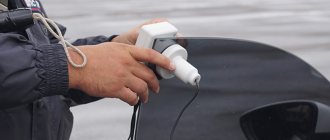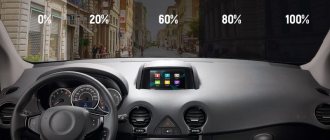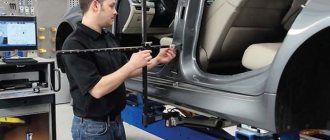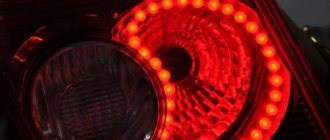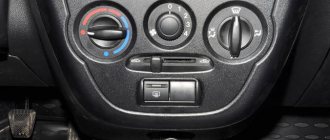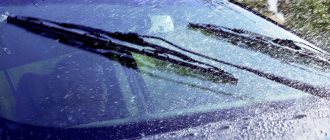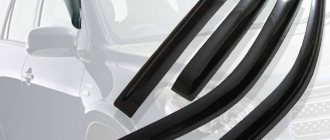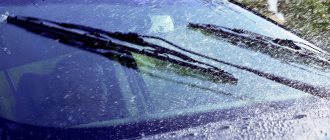The law on tinting today
Legislative regulation of auto glass tinting is regulated by the rules approved by State Standard No. 32565 of 2013 “Safe glass for land transport . According to the regulations, a car driver has the right to:
- Tint the rear and rear side windows, there are no restrictions on light transmission;
- Dim the windshields (side front) windows: when tinted, they must transmit at least 70% of the light;
- Apply tint to the windshield in the form of a strip up to 14 cm wide; the norm for its light transmission is not established. The strip protects the driver's eyes from the sun and does not interfere with the view of the road situation.
These requirements are justified and reasonable, and their implementation is subject to road safety standards. Breaking the rules is dangerous primarily for the driver himself.
There is an exception for company cars, the tinting of which is determined by the specifics of the activity. An example would be the machines of cash-in-transit banking services. A special permit is issued for such vehicles.
This is interesting: What needs to be done to register a car
The nuances of tinting car windows
In practice, it is not enough to look only at light transmittance; there are also some nuances in tinting that drivers forget. But, they can lead to a fine.
The first is the use of tint film. In fact, by sealing the glass, we make changes to the technical characteristics of the vehicle. And this is fraught with a fine. Are you surprised? No, let’s try to tell you why experts think so.
Each glass in a car has its own characteristics, primarily to ensure safety in case of an accident. For example, the front glass does not break into fragments, or rather breaks, but the impact must be very strong for this to happen. But the glass of the front doors, on the contrary, crumbles into small crumbs, and this crumb does not have sharp edges.
By gluing the film we change the technical and physical parameters of the glass. For example, the side glass no longer shatters upon impact, which does not comply with GOST. It might even become traumatic. It is generally unknown how glass tinted with film will behave in an accident. Accordingly, we made an unsafe change to the technical characteristics of the vehicle.
In practice, inspectors on the road do not bother with such tinting. But the presence of statements about the unsafety of this method of tinting suggests that sooner or later this standard will be introduced.
You cannot use film that has a greenish tint. It is equivalent to a mirror image, which means it is prohibited. If you can use color films of other colors on the rear windows, it is better not to use mirror films with a green tint.
Be careful with the inscriptions. There should be no writing on the windshield. If you change your windshield, do not buy one with the inscription on it. If you can remove the film with the inscription right in front of the inspector, although you will have to tinker, then you won’t be able to pick out the inscription from the triplex, you will have to leave on a tow truck. Or even pick up the car from the impound lot.
If you buy already tinted glass, not only look at the certificates, be sure to ask the seller to check the level of light transmission with you.
What is the punishment?
Having figured out what tinting is allowed, you need to familiarize yourself with the punishment for violating the rules. This year, non-compliance of tinting with established standards is fraught with sanctions:
- Imposition of a fine for tinting in the amount of 500 rubles. (Article 5 of the Administrative Code).
- Since November 2014, the inspector has no right to remove license plates from vehicles as punishment for improper tinting (changes in the Administrative Code).
- Request for tinting.
Any employee of the State Traffic Inspectorate, not only a technical supervision officer, can verify the adequacy of light transmission.
The amount of the fine for tinting is a constant value and does not vary depending on the light transmission or the number of tinted windows.
The car owner receives the order for tinting along with a formalized resolution imposing a fine. The main requirement of the document is to remove the tint film within a specified period (10-14 days). If the conditions are not met, the driver may be detained for 15 days as a punishment.
Responsibility for violating the rules
Violation of the rules of tinting entails liability under Part 1 of Art. 12.5 of the Code of Administrative Offenses of the Russian Federation with a penalty of a fine of 500 rubles. An order will also be issued to eliminate the violation - usually within 1 day. When paying in the first 10 days, a 50% discount (250 rubles) is provided.
If the driver is ready to correct the violation on the spot and can remove the tint, the inspector will issue a warning.
For failure to comply with the order or failure to pay the fine, the driver faces an additional fine of 1,000 rubles. or arrest for up to 15 days. These cases are considered exclusively in court. As practice shows, arrest is applied only to persistent violators in exceptional cases.
Athermal tinting: allowed or not?
It's no secret that in the absence of film the car gets very hot. Even the presence of climate control does not show sufficient efficiency; passengers sweat.
Thanks to the inclusion of metal particles in the coating on glass, it is possible to achieve several advantages:
- the interior heats up more slowly;
- the need to use air conditioning is reduced;
- fuel consumption decreases;
- the atmosphere improves due to reduced gas emissions.
With strong darkness, the same effects occur, but there will be problems with the traffic police. When choosing what kind of tinting you can tint your front windows, you should take a closer look at the athermal material. When using athermal film, the interior remains clearly visible, the amount of light transmitted is about 90%, but it effectively reflects ultraviolet and infrared radiation, which leads to heating.
If you glue an athermal film to the windshield, you can improve the characteristics of the glazing and experience a number of advantages:
- gluing film is permitted by GOST, since the permissible percentage of 70% is observed, usually higher - 80-90%;
- the interior does not experience strong heating from the sun, as a result, the interior retains its new appearance for a long time;
Athermal tinting Lada Vesta
- at night the driver is protected from being blinded by oncoming cars;
- tinting improves the aesthetic perception of the car due to the transfusion effect;
- tinting helps to reduce the visibility of the interior from the outside.
An alternative option is to stick on one of the varieties of athermal material popularly called “chameleon”. The material changes the level of darkness depending on the lighting; on a clear day the film protects more, and on a cloudy day it blocks out less light. The selection rules are the same - the main condition is to maintain a permeability of at least 70%.
Glass tinting according to GOST in Russia
In 2014, the rules that control the light transmittance of car windows underwent some changes. The permissible amount of light that the film transmits has been reduced to 70%. Now you can tint the front glass according to GOST in the same way as the side windows.
As for light transmission checks, the official website of the road service in Russia gives the following explanation: “only traffic police officers with a special rank can:
- involve the driver in checking;
- use appropriate technical tools;
- initiate an administrative case;
- make conclusions on the elements of the offense.
What does it mean? Any transport police officer can check your windows for the level of tinting, since all traffic police officers have a “special rank”.
Of course, for this he will need not only a wand, but also a taumeter. It should be remembered that in unfavorable external conditions (when the taumeter data cannot be considered objective), or in the absence of seals on the device, you have every right to refuse to check the light transmittance of your car windows in road conditions. The driver also has the right not to go to the stationary inspection point.
To detain a car, it is necessary that the violation has already been identified, and not just assumed.
You can find a list of documents required to replace a driver’s license for foreign citizens on our website.
Some components of a new car require running-in and lapping. Read more here. Complete break-in procedure, starting with the chassis and ending with the air conditioning.
In critical situations, this article /tehobsluzhivanie/alert/zavodit-mashinu-bez-klyucha.html will help you start the car without a key.
Why has the permitted percentage of tinting on front windows been reduced in the new GOST?
The light transmission of clean and completely new glass is not 100%, the maximum is 85%. If you take a standard film, most often the light transmission rate is 75%. If we take both indicators into account, the result will be: 0.85 * 0.75 = 0.64%. It turns out that film, by old standards, was always illegal.
The highest coefficient for the new film is 80-90%. According to basic calculations, installing film on the front glass was initially an illegal procedure. Taking into account the fact that with use the indicator decreases to 75-80%, the film always led to exceeding the normal limits. Light transmission can only be achieved by installing a light-colored film (90%) on new glazing (85%).
Formula: 0.9*0.85 = 76.5%.
Car front window tinting
In reality, it was almost impossible to tint the front car windows to achieve 75%. The indicator was always below the norm. For this reason, the percentage was reduced in GOST 32565-2013.
Tinting of the front side windows, as well as the windshield, is allowed, but a preliminary calculation is made of how much light will pass through, taking into account the indicator of the film, glass and deterioration during operation.
How to avoid being included in the list of those fined?
The most effective way to prevent a fine from being issued is to remove the tint completely, but this is an extreme option. A more conservative method is to lower the front side windows, but this can only be used in the summer.
The main problem is that full compliance with GOST standards is not 100% protection from receiving a fine. The risks are especially high for owners whose degree of tint is within acceptable limits, but approaches 70%. Devices for measuring light transmittance have operating errors; there is a high probability that the device will determine the glass as not meeting the standards.
There is an option to tint the glass with a light transmittance of 70-72% and avoid fines - take the permit with you. If there is an expert opinion, the traffic police should not find fault, but there are still no guarantees.
Fine for tinting car windows
The best way to protect yourself from a fine is to leave a gap of a few percent, then the suspicions of the traffic police will definitely be dispelled. If employees insistently demand measurements, your task is to demand careful compliance with all standards for using the device. Before checking, the air temperature and humidity level are determined. If the threshold is exceeded, the device will not provide reliable results.
When receiving readings that violate the requirements, the driver has the right to request a repeat measurement using another device. If the employee does not agree to repeat the procedure, a record of this is made in the protocol. Additionally, you can clarify the series and number of the device, and then appeal the results during the legal process. If the outcome is successful, an independent examination is appointed.
This is interesting: What is adaptive cruise control
Tinting and fines
If a traffic police officer, after conducting an examination, decides to impose a fine, make sure that the measurement results really do not meet the requirements of GOST. Even 1% deviation from the norm is a violation. Any removable tinting elements, be it double glazing or dark curtains for the side front windows, are unacceptable and will also be subject to a fine. The fine for violating the rules of tinting (500 rubles) can be paid with a 50% discount within 20 days from the date of the decision.
Over time, any film, even the highest quality, can wear out and become cloudy, becoming darker. The means to return the tint to its previous qualities have not yet been invented, so the film is simply re-glued.
As for the frequency of imposing a fine, a special procedure applies. In accordance with the law, a repeated fine for violating tinting requirements can be imposed only one day (24 hours) after a similar decision is issued. The protocol drawn up by the traffic inspector must contain the exact date and time the fine was issued. Be sure to present a “fresh” resolution if people in uniform try to fine you again. Only the court has the right to impose a fine again; traffic police officers cannot do this.
Nowadays, repeated violation of the requirements for tinting car windows is punishable by a fine, but in the future, for non-compliance with these rules, the driver may be deprived of his license - parliamentarians have already raised this topic for discussion several times.
Pasting glass with film only at first glance seems like an easy task, but in fact it requires skills and a lot of experience.
If you are not confident in your abilities, it is better to turn to professionals. Specialists from official FAVORIT MOTORS service centers offer a wide range of services for diagnostics, repair and maintenance of your car. Our technicians constantly improve their skills in the training centers of automakers and have a high level of competence in identifying and troubleshooting cars of any brand. All work is carried out with a guarantee and on time. Sign up for service Service center contactsAsk a question
Rules for measuring tinting in accordance with the law
Light transmittance measurements must be made using a specific standardized technique. In practice, traffic police inspectors often determine the quality of tinting by eye, giving a subjective assessment.
The driver must be aware of the existence and content of the Ministry of Internal Affairs Order No. 1240 of 2000, which establishes the rules for technical supervision of the State Traffic Safety Inspectorate in relation to vehicles.
Research can be carried out by an employee authorized to work with a technical supervision device.
The measuring instruments (taumeters) used must be certified by a state laboratory; the documentation requires information about their verification. The serviceability of the taumeter is confirmed by a seal. If the latter is damaged, the device is considered faulty and cannot be used to monitor the light transmission of tinted glass.
Measurements are carried out under certain atmospheric conditions: research is prohibited in bad weather.
How to measure tint
Traffic police inspectors must monitor compliance with light transmittance standards. For this, a special device is used, which must be sealed and have technical documentation. Before checking, the driver has the right to ask to see the device and check its integrity, as well as the absence of contamination and additional darkening layers.
If you disagree with the results, the driver may demand repeated control, but in the presence of two witnesses.
Measurements must be carried out at certain pressure, humidity, temperature and light levels. If at least one of the conditions is violated, the fine can be appealed and canceled.
What instruments measure the light transmittance of glass?
Light transmission measurements are carried out by an inspector. It is worth considering that the results always have an error, it is mostly insignificant, but if the rules of use are not followed, the deviation may increase. The results are affected by temperature, humidity and pressure.
The traffic police are armed with several types of devices:
- "Light". The light emitter and receiver are equipped with magnets, which makes the device easier to use. The rules indicate the need to take measurements at least 3 times. The real indicator is the arithmetic average of all measurements. The advantage of the device is its resistance to low temperatures;
Tonic device for checking tinting
- "Tonic". Both detectors have to be held manually, which often leads to errors. A mandatory requirement for correct measurement is strict coincidence of the marks on both sides of the device. Operates at temperatures from -10°C to 40°C;
- AKL-2M. Violation of the results occurs when the rubber gaskets do not fit tightly. The use of the device is permitted only at temperatures above 10°C.
The principle is the same in each case: the emitter is installed on one side, and the receiver on the other. When applying both elements to each other, the indicator should be 100%. If there is glass between them, the result will always be lower.
Correct results for each device are only obtained when attached to dry glass.
Athermal film
In the hot season, you can hardly go anywhere without darkening the windows. The car interior gets so hot that even using air conditioning does not improve the situation. The optimal solution in this situation is permitted tinting, the role of which is performed by athermal darkening.
Its light transmittance is approximately 90%. At the same time, infrared and ultraviolet rays, passing through such darkness, are significantly weakened. Athermal film has the following advantages:
- No overheating of the vehicle interior.
- In combination with the windshield, the light transmittance of such tinting is about 80%, which complies with all accepted standards.
- At night, the driver will not be blinded by the headlights of an oncoming vehicle.
- From the outside, the interior of the car is visible an order of magnitude worse than without any film at all.
The visible part of the incident light rays will not be weakened. This means that for rear windows it is better to use a different tinting option or the one indicated, but in combination with car curtains.
Some drivers, after being stopped for tinting their front windows, remove the film in the presence of an inspector. The purpose of these manipulations is to avoid imposing a fine, which is impossible in principle. The only thing a car owner can count on is the absence of repeated sanctions for the same violation.
Side window tinting
According to GOST, side windows must transmit at least 70 percent of sunlight. It is worth noting that tinting itself is not illegal, but even if GOST standards are observed, not all tinting methods are permitted by law. More about this:
Mirror effect
It is important to immediately note that tinting in this way is prohibited for any type of glass. This is explained by the fact that the mirror surface can distort the light of the headlights, thereby misleading the driver and causing an accident.
Athermal toning or chameleon
This tint has a blue or green tint, which does not quite comply with GOST rules. However, both the drivers themselves and the traffic police officers in the case of such tinting pay attention only to the light transmittance.
Dear reader! Didn't receive an answer to your question? Our expert lawyers work for you. It's absolutely free!
- Moscow ext 152
- St. Petersburg ext 152
- All regions ext 132 (Toll free)
Standard tinting
It is produced by car manufacturers themselves, adding tinting additives to the glass mass or using vacuum plasma spraying. It is impossible to get rid of this effect without complete dismantling. However, car manufacturers often take into account the tinting standards for those countries where they plan to deliver vehicles.
Self-spraying with metals or polymers
Its effect is close to the factory one, however, during use, the tinted surface gets scratches and chips. It will not be possible to change the light transmittance of such glass, similar to standard glass, without dismantling it.
Tinting film
This film is glued to the outer surface of the glass. This method is distinguished, firstly, by the speed of the installation process, secondly, by its low cost, and thirdly, by the ease of dismantling if necessary. Today, the market offers a wide range of such films, where drivers can choose materials of various colors, classes and light transmission coefficients in accordance with their preferences and budget capabilities. The disadvantage of this method of tinting front windows is that the film is not always removed without damage.
GOST rules
According to the requirements of GOST 32565–2013, which replaced GOST 5727–88, the light transmittance of the windshield cannot be less than 75%. For front side windows this figure is 70%. The rear hemisphere is not subject to classification. It is important that the film should not distort the driver’s perception of the following colors:
- red,
- yellow,
- green,
- blue,
- white.
The standard allows for a light-protective strip on the windshield no more than 15 cm thick from the roof. Dull tinting of the rear hemisphere is allowed only if there are two working rear-view mirrors (left and right, respectively).
Windshield tinting rules
The requirements for a car windshield are the most stringent. Let's list the main points.
- Minimum light transmission - 70%.
- Mirror and color tinting is prohibited.
- The color stripe must be of a strictly defined thickness.
Let's look at these points in more detail, first of all, comparing them with the previous requirements.
The new GOST implies a light transmission of 70%, previously it was 75%. It turns out that the windshield can be tinted more strongly using a darker film. Although in practice you probably won’t even notice a 5% difference.
There should not be any mirror film on the windshield. This is a gross violation for which the inspector will fine you even without measuring the level of light transmission. The same can be said about color films. No yellow or green glass should be used.
A narrow colored stripe may be used on top of the windshield. The width of the strip should not exceed 140 mm, and should not be in the area of effect of the windshield wipers. Wipers cleaning the windshield should not enter the lane.
Regarding the stripe, it is worth adding that sometimes you can get a fine for it. The fact is that GOST imposes the same requirements on it as on the rest of the glass, that is, the level of light transmission must be at least 70%. This means the strip should be transparent.
Also, there cannot be any inscriptions or extraneous stickers on the windshield. The inscription on the colored stripe is also a violation. Usually, road inspectors do not pay attention to the inscription on the lane, but if they want to get to the bottom of it, they can issue a fine. They have a right. Just keep this in mind.
If there is a violation of the windshield tinting, the inspector may not only fine you, but also prohibit further movement, citing safety requirements.
Features of choosing tinting
When dealing with the question of what tinting is allowed on the front windows, you must also take into account an important nuance. The new GOST has two definitions for car windows (categories 1 and 2). The first group includes glass that provides the driver with forward visibility, and the second - rear visibility. The manufacturer in the technical documentation of the machine indicates the so-called “point R”, from which you should start when choosing a tinting method and its maximum permissible level. Car service specialists will help you determine the categories of glass for the correct application of protection.
Typically, the glasses of the first group are tinted from 25 to 30%, or the film cannot be applied at all if there are no rear-view mirrors. Windows of the second category, located behind the plane defined by point R, can be darkened to a maximum (100 percent). The only important condition is the mandatory presence of two external mirrors, providing the driver with ideal rear visibility.
According to the traffic rules, in cars, jeeps or minibuses equipped with outside rear-view mirrors on the right and left, it is permissible to use curtains or blinds on the side and rear windows.
It is worth considering that an additional violation is considered to be gluing a colored film to the side and front windows of a car, which distorts the color rendition: yellow, green, red and white.
Thus, car owners must adhere to the following tinting regulations in 2021:
- The permitted percentage of tinting on front windows in 2021 is 70%;
- You can darken the rear side windows without restrictions if you have side mirrors;
- The rear window can be protected either with a tinted athermal film or with blinds or curtains;
- The front glass can be tinted with a transparent colored film in its upper part with a tinting height of no more than 140 mm.
Automatic electronic tint is an acceptable option
Electronic window tinting is a modern technology that allows you to adjust the transparency of glass. It is used in many modern luxury cars.
Due to the ability to vary light transmission, drivers of a car with electronic tinting practically do not risk running into a fine, since at the time of testing it is possible to set any degree of transparency of the glass and it is not possible to prove that when driving on the road it differed from the established one.
The only drawback of this method is the price: the cost of electronic tinting is quite high, and its installation in non-factory conditions requires serious professional service.
Rear window tinting
According to GOST, the percentage of rear window tinting can be any. As a rule, traffic police officers never check it. The rear window can at least be completely sealed with an opaque film. This fact is not a reason for imposing a fine, since it does not violate the law or GOST. Thus, the rear window can be darkened in any way.
Regulatory acts that allow you to avoid checking light transmission by traffic police officers
If you are afraid that you will be fined for exceeding the permissible tinting standards, you can use the following facts to justify yourself:
- The correctness of the tinting can only be checked with a taumeter (“Blik” or analogues). Without it, verification is prohibited;
- The device must undergo certification. A seal on the case and a certificate of successful completion of testing of the taumeter to demonstrate true readings are also required. Damage (or a copy) of the seal and lack of certification in the hands of a traffic police officer exempt you from inspection;
- Checking the tint in the rain or when the air humidity is from 45 to 80% is not indicative. Employees must provide a clean, dry environment;
- The air temperature during the test cannot be lower than +10 degrees;
- The inspector must have equipment to pre-check humidity levels, pressure and temperature. In the absence of these, checking the tint is impossible;
- A check without witnesses is unacceptable;
- Tint measurements are carried out only at stationary posts. The traffic police are automatically cut off from the bushes.
We offer professional car tinting services. All standards will be strictly observed! We provide a result that will not arouse suspicion among the traffic police and will allow the vehicle owner to undergo maintenance without any problems.
Order from us:
- Athermal tinting
- Tinting according to GOST
- Removing old tint
The following is often ordered along with tinting:
- Car soundproofing
- Car protection with polyurethane film
- Car protection with ceramics
- Interior dry cleaning
- Polishing paintwork
- Airbrush
Requirements for checking tint
Compliance of the tinting of the side front windows of a car with GOST is determined during the inspection process using a special device - a taumeter. There is a fairly extensive set of laws that law enforcement officers must follow when checking car windows.
If your car has tinted windows, remember the following rules:
Light transmission testing should be carried out exclusively at stationary police posts.- During rain or air humidity of 45-80%, testing should not be carried out.
- Light transmission control is carried out only on dry and clean glass.
- The test must be carried out at 3 different points on each glass being tested.
- At the beginning of the inspection, the police officer must check the atmospheric pressure (atmospheric pressure must be between 645-795 mm).
- The police officer conducting the check must have the appropriate mark on his certificate.
- The taumeter must be certified and have a seal.
- At what temperature can tint be measured? The temperature should be between +15 and +25 C.
Is it possible to measure tint at night? It is forbidden to take measurements in rainy or dirty weather, but there are no restrictions on the time frame - you can check the tint even late at night.
Questions and answers on the topic
Is tinting allowed in Russia?
Excessive tinting of car windows is illegal. The permissible percentages of light transmittance are reflected in GOST. Dimming the front window and side windows is permitted only within the prescribed values.
Do all types of glass have the same tinting requirements?
GOST adopted by law establishes different levels of minimum light transmission. For example, the shading of the front side windows should not be higher than 30 percent, and for the second row the shading level is not regulated at all.
What is the fine for tinting in 2021?
If a traffic police inspector during an inspection reveals that the permissible percentage of light transmittance is exceeded and does not comply with GOST adopted by law, the officer has the right to issue a fine in the amount of 500 rubles.
How to determine the level of tint?
To check the percentage of light transmittance, the traffic police inspector uses special certified devices according to the methodology described in GOST. It is more difficult to independently calculate the degree of tinting, but you can use a simple formula in which the light transmittance coefficients of glass and film are multiplied.
Bypassing the law for tinting lovers (tinting allowed by GOST)
A special device for measuring light conductivity does not notice tints with 100% conductivity. Through such a film it will be very difficult to see anything in the car. However, at the same moment, a special device during measurement will reveal 100% light conductivity. This is achieved due to a special tinting technology that has several layers of coating.
Main distinctive features
It is imperative to require the submission of a document indicating that the special device for measuring light transmittance does not malfunction, and a technical passport of the device used for measuring purposes. The inspector must also have a document confirming the last verification of the device. The driver must check whether everything declared meets the above requirements.
Thus, for example, the most popular “Blik” sensor, whose technical characteristics make it possible to perform measurements at temperatures above 100C, showed unreliable information. The newly introduced “Light” device, as it turned out in the process, is far from new. “Svet” was entered into the state register in 2008. Now it is permissible to use it all year round, but still only on dried and cleaned glass.
Before tinting a car yourself or with a specialist, you need to measure in advance and only then, having found out the permitted standard, use tinting according to GOST, without neglecting the calculation formula (auto glass% x film with selected %) and adding 2% for the device error to the result obtained.
It is not necessary to go to the traffic police post to measure the permitted tint according to GOST, since according to the law, the officer must first carry out an administrative arrest.
However, according to Part 1 of Art. 27.3 of the Code of Administrative Offenses, you need to find out that in order to prove a crime, an arrest cannot be made. For the same reason, the detention process provided for by administrative regulations can be carried out only after proof of an offense, but not before it. As a result, it should be said that it is recommended to inquire about the color of the tint film. At the moment, it is unacceptable to use yellow and green, white and red, this is a violation. Only expensive, high-quality film guarantees a favorable result.
